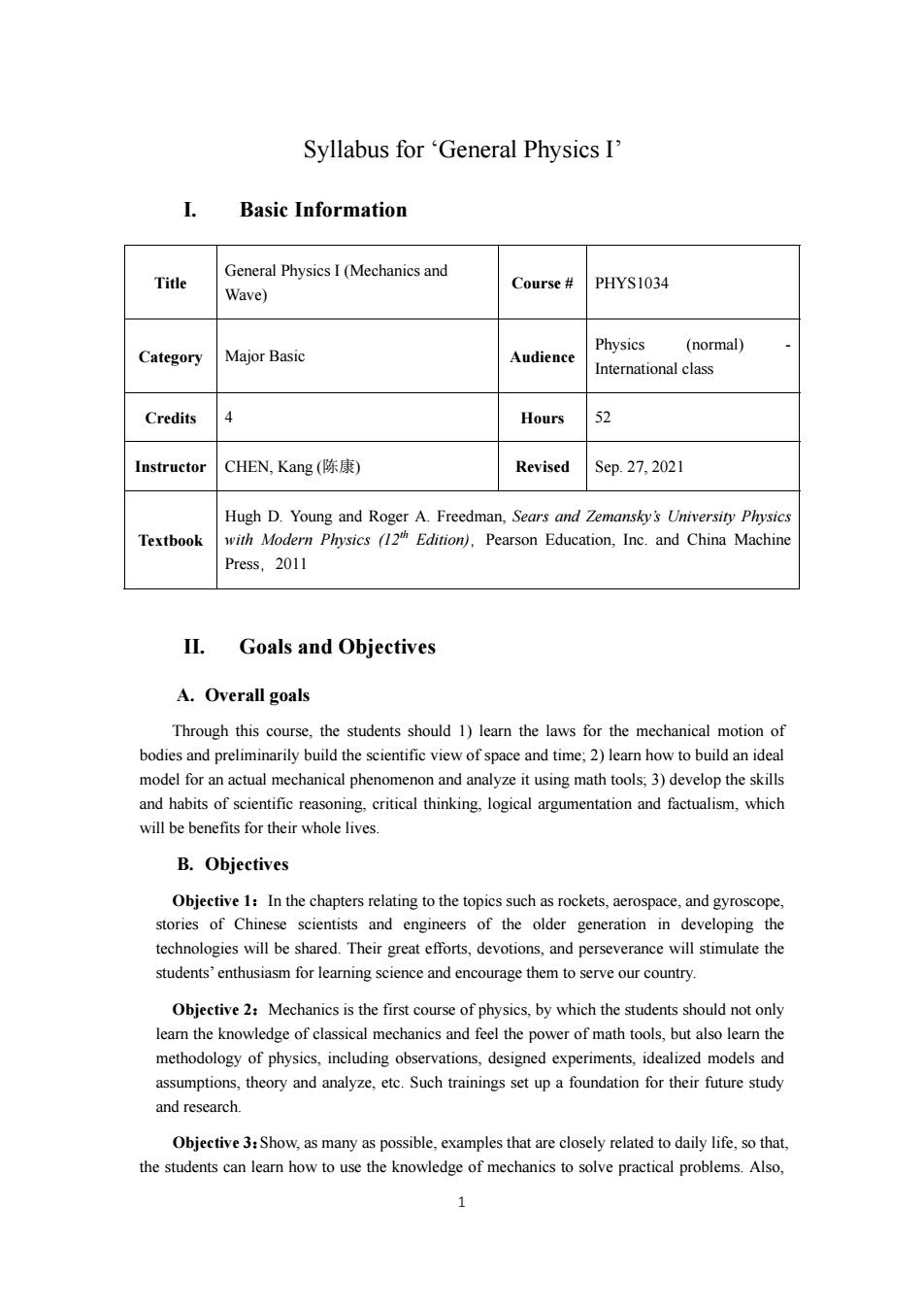
Syllabus for'General Physics I' Basic Information Title General Physics I(Mechanics and Course HYS1034 Wave) Physics (normal) Category Maior Basic Audience International class Credits 4 Hours 52 Instructor CHEN,Kang(陈康) Revised Scp.27,2021 Hugh D.Young and Roger A.Freedman,Sears and Zemansky's University Physic with Modern Physics (12h Edition),Pearson Education,Inc.and China Machine Press.2011 II.Goals and Objectives A.Overall goals Through this course,the students should 1)learn the laws for the mechanical motion of bodies and preliminarily build the scientific view of space and time;2)learn how to build an ideal model for an actual mechanical phenomenon and analyze it using math tools:3)develop the skills and habits of s thinking logicl argumentation and will be benefits for their whole lives B.Objectives Objective 1:In the chapters relating to the topics such as rockets,aerospace,and gyroscope stories of Chinese scientists and engineers of the older generation in devel technologies will be shared.Their great fors,devotions,and persever students'enthusiasm for learning science and encourage them to serve our country. Objeetive 2:Mechanics is the first course of physics,by which the students should not only learn the knowledge of classical mechanics and feel the power of math tools.but also learn the methodology of physics.including observations.designed experiments,idealized models and assumptions,theory and analye.te.Such trainings set upa foundation for ther future study and research Objective3:Show,as many as possible,examples that are closely related to daily life,so that the students can learn how to use the knowledge of mechanics to solve practical problems.Also
1 Syllabus for ‘General Physics I’ I. Basic Information Title General Physics I (Mechanics and Wave) Course # PHYS1034 Category Major Basic Audience Physics (normal) - International class Credits 4 Hours 52 Instructor CHEN, Kang (陈康) Revised Sep. 27, 2021 Textbook Hugh D. Young and Roger A. Freedman, Sears and Zemansky’s University Physics with Modern Physics (12th Edition),Pearson Education, Inc. and China Machine Press,2011 II. Goals and Objectives A. Overall goals Through this course, the students should 1) learn the laws for the mechanical motion of bodies and preliminarily build the scientific view of space and time; 2) learn how to build an ideal model for an actual mechanical phenomenon and analyze it using math tools; 3) develop the skills and habits of scientific reasoning, critical thinking, logical argumentation and factualism, which will be benefits for their whole lives. B. Objectives Objective 1:In the chapters relating to the topics such as rockets, aerospace, and gyroscope, stories of Chinese scientists and engineers of the older generation in developing the technologies will be shared. Their great efforts, devotions, and perseverance will stimulate the students’ enthusiasm for learning science and encourage them to serve our country. Objective 2:Mechanics is the first course of physics, by which the students should not only learn the knowledge of classical mechanics and feel the power of math tools, but also learn the methodology of physics, including observations, designed experiments, idealized models and assumptions, theory and analyze, etc. Such trainings set up a foundation for their future study and research. Objective 3:Show, as many as possible, examples that are closely related to daily life, so that, the students can learn how to use the knowledge of mechanics to solve practical problems. Also

each student is asked to find and analyze an actual mechanical phenomenon by himself and hand d.To develop the ab before class and moreover study the chapters of elasticity and fluid mechanics by Objective4:By discussions of the fundamental concepts,such as frame of reference,force, implications behind Newton's laws,the students are guided to think about the fundamentals of our universe andto fee theart of logic and reasoning.These deep motivate their interests in and pursuit of truth.All-English teaching would improve their ability in communicating internationally and reading the scientific materials in English C.Correlations-Objectives,graduation requirements,teaching contents Table 1:Correlations between course objectives,graduation requirements and teaching contents Objectives Teaching contents Graduation requirements Contents of all chapters.Examples include:Chapter Introduction(China's contribution in SI unit"Kilogram") Chapter 2 Particle Dynamics(C.N.Yang's contribution in Gauge Theory):Chapter 4 Momentum.Impulse and Collision (China's achievements in developing missiles and rockets) Requirements3 Chapter5 Rotation of Rigid Bodies(Application of gimba and observation of precession of the equinoxes in ancien China:Story of China's laser gyroscope):Chapter 7 Gravitation(China's achievements in aerospace engineering) Contents ofAll chapters in whichChapter Introduction and Objective 2 Review of Calculus and Vectors"reviews the prerequisite Requirements 2-1 to 2.3.3 math tools. Contents ofAll chapters in which "Chapter 6 Elasticity"and Objective 3 Requirements 2-1 to "Chapter9 Fluid Mechanics"are for self-taught. 2-3,7,8 Contents ofAll chapters.Deep discussions on the conceptsof Objective 4 reference frame,force,space,etc.are given mostly in "Chapte 2-3.5,7.8 1Kinematics"and"Chapter 2 Particle Dynamics
2 each student is asked to find and analyze an actual mechanical phenomenon by himself and hand in a report at the end. To develop the habit of self-education, the students are asked to preview the context before class and moreover study the chapters of elasticity and fluid mechanics by themselves. Objective 4:By discussions of the fundamental concepts, such as frame of reference, force, implications behind Newton’s laws, the students are guided to think about the fundamentals of our universe and to feel the art of logic and reasoning. These deep discussions could motivate their interests in science and pursuit of truth. All-English teaching would improve their ability in communicating internationally and reading the scientific materials in English. C. Correlations—Objectives, graduation requirements, teaching contents Table 1: Correlations between course objectives, graduation requirements and teaching contents Objectives Teaching contents Graduation requirements Objective 1 Contents of all chapters. Examples include: Chapter 0 Introduction (China’s contribution in SI unit “Kilogram”); Chapter 2 Particle Dynamics (C. N. Yang’s contribution in Gauge Theory); Chapter 4 Momentum, Impulse and Collisions (China’s achievements in developing missiles and rockets); Chapter 5 Rotation of Rigid Bodies (Application of gimbal and observation of precession of the equinoxes in ancient China; Story of China’s laser gyroscope); Chapter 7 Gravitation (China’s achievements in aerospace engineering). Requirements 3 Objective 2 Contents of All chapters in which “Chapter 0: Introduction and Review of Calculus and Vectors” reviews the prerequisite math tools. Requirements 2-1 to 2-3, 3 Objective 3 Contents of All chapters in which “Chapter 6 Elasticity” and “Chapter 9 Fluid Mechanics” are for self-taught. Requirements 2-1 to 2-3, 7, 8 Objective 4 Contents of All chapters. Deep discussions on the concepts of reference frame, force, space, etc. are given mostly in “Chapter 1 Kinematics” and “Chapter 2 Particle Dynamics” Requirements 2-1 to 2-3, 5, 7, 8
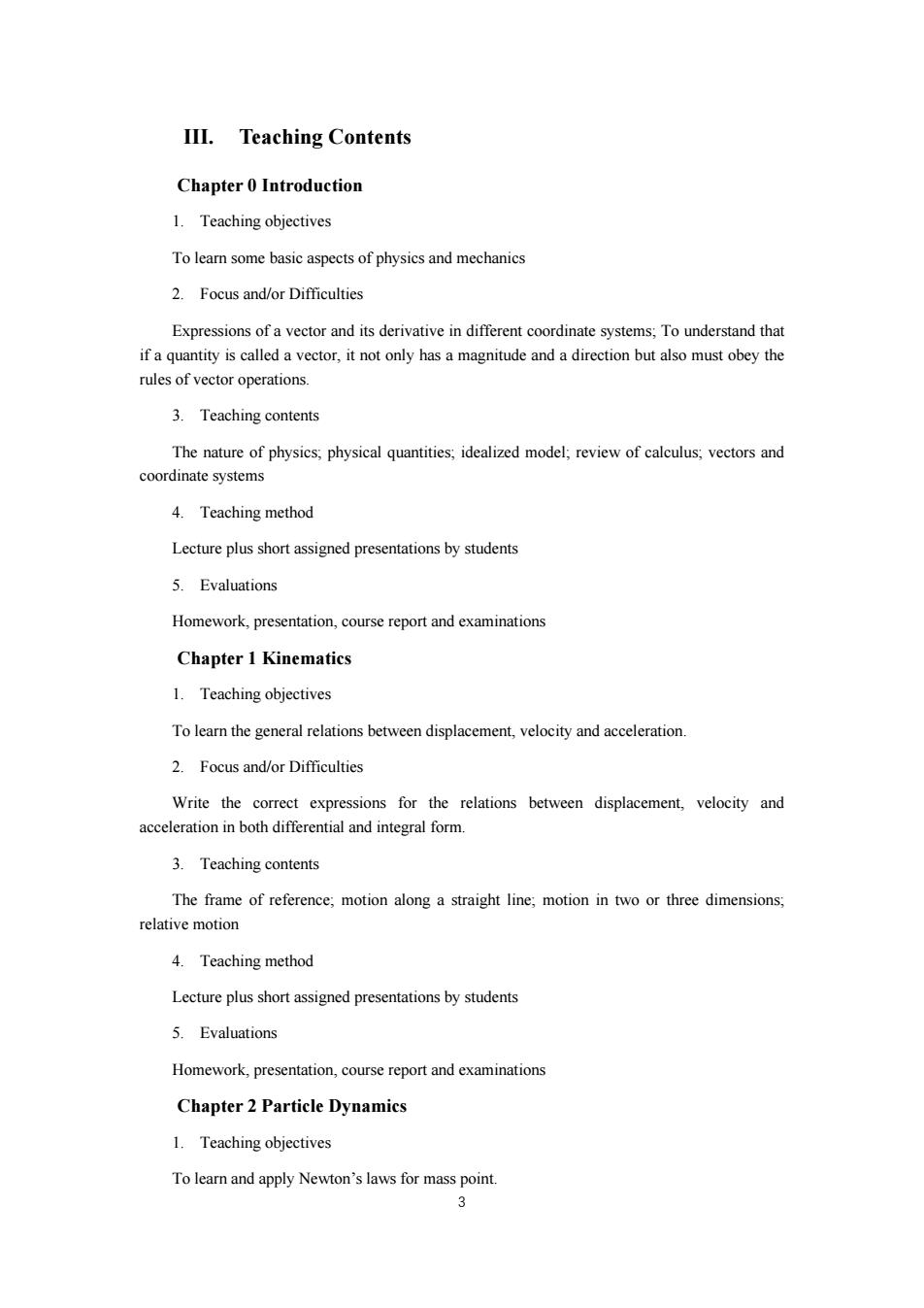
III.Teaching Contents Chapter 0 Introduction 1.Teaching objectives To leam some basic aspects of physics and mechanics 2.Focus and/or Difficulties Expressions of a vector and its derivative in different coordinate systems:To understand that if a quantity is called a vector,it not only has a magnitude and a direction but also must obey the rules of vector operations. 3.Teaching contents The nature of physics,physical quantities.idealized model review of calculus,vectors and coordinate systems 4.Teaching method Lecture plus short assigned presentations by students 5.Evaluations Homework,presentation,course report and examinations Chapter 1 Kinematics 1.Teaching objectives To lear the general relations between displacement,velocity and acceleration. 2.Focus and/or Difficulties Write the correct expressions for the relations between displacement,velocity and 3.Teaching contents The frame of reference;motion along a straight line;motion in two or three dimensions. relative motion 4.Teaching methoc Lecture plus short assigned presentations by students 5.Evaluations Homework,course report and examination Chapter 2 Particle Dynamics 1.Teaching objectives To leam and apply Newton's laws for mass point. 31
3 III. Teaching Contents Chapter 0 Introduction 1. Teaching objectives To learn some basic aspects of physics and mechanics 2. Focus and/or Difficulties Expressions of a vector and its derivative in different coordinate systems; To understand that if a quantity is called a vector, it not only has a magnitude and a direction but also must obey the rules of vector operations. 3. Teaching contents The nature of physics; physical quantities; idealized model; review of calculus; vectors and coordinate systems 4. Teaching method Lecture plus short assigned presentations by students 5. Evaluations Homework, presentation, course report and examinations Chapter 1 Kinematics 1. Teaching objectives To learn the general relations between displacement, velocity and acceleration. 2. Focus and/or Difficulties Write the correct expressions for the relations between displacement, velocity and acceleration in both differential and integral form. 3. Teaching contents The frame of reference; motion along a straight line; motion in two or three dimensions; relative motion 4. Teaching method Lecture plus short assigned presentations by students 5. Evaluations Homework, presentation, course report and examinations Chapter 2 Particle Dynamics 1. Teaching objectives To learn and apply Newton’s laws for mass point
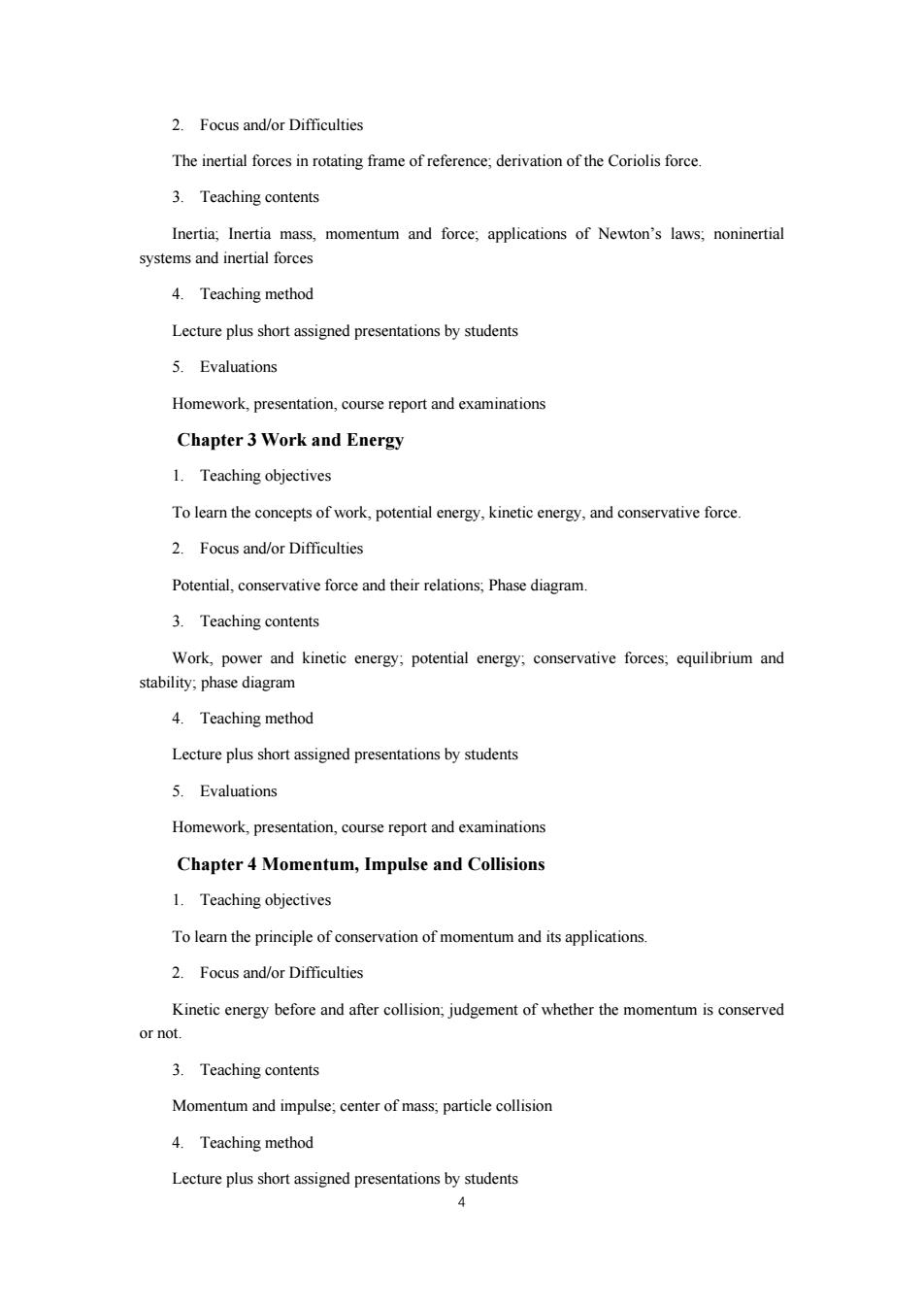
2.Focus and/or Difficulties The inertial forces in rotating frame of of the Coriolis force 3.Teaching contents Inertia,Inertia mass,momentum and force,applications of Newton's laws;noninertial systems and inertial forces 4.Teaching method Lecture plus short assigned presentations by students 5.Evaluations Homework,presentation,course report and examinations Chapter 3 Work and Energy 1.Teaching objectives To learn the concepts of work,potential energy,kinetic energy,and conservative force. 2.Focus and/or Difficulties Potential,conervative force and their relations,Phase diagram. 3.Teaching contents Work,power and kinetic energy;potential energy,conservative forces;equilibrium and stability,phase diagram 4.Teaching methoc Lecture plus short assigned presentations by students 5.Evaluations Homework presentation,ous repor and xamination Chapter 4 Momentum,Impulse and Collisions 1.Teaching objectives Toleam the principle of conservation of momentum and its applications 2.Focus and/or Difficulties Kinetic energy before and after collision,judgement of whether the momentum is conserved or not. 3.Teaching contents Momentum and of mass,particle colision 4.Teaching method Lecture plus short assigned presentations by students 4
4 2. Focus and/or Difficulties The inertial forces in rotating frame of reference; derivation of the Coriolis force. 3. Teaching contents Inertia; Inertia mass, momentum and force; applications of Newton’s laws; noninertial systems and inertial forces 4. Teaching method Lecture plus short assigned presentations by students 5. Evaluations Homework, presentation, course report and examinations Chapter 3 Work and Energy 1. Teaching objectives To learn the concepts of work, potential energy, kinetic energy, and conservative force. 2. Focus and/or Difficulties Potential, conservative force and their relations; Phase diagram. 3. Teaching contents Work, power and kinetic energy; potential energy; conservative forces; equilibrium and stability; phase diagram 4. Teaching method Lecture plus short assigned presentations by students 5. Evaluations Homework, presentation, course report and examinations Chapter 4 Momentum, Impulse and Collisions 1. Teaching objectives To learn the principle of conservation of momentum and its applications. 2. Focus and/or Difficulties Kinetic energy before and after collision; judgement of whether the momentum is conserved or not. 3. Teaching contents Momentum and impulse; center of mass; particle collision 4. Teaching method Lecture plus short assigned presentations by students
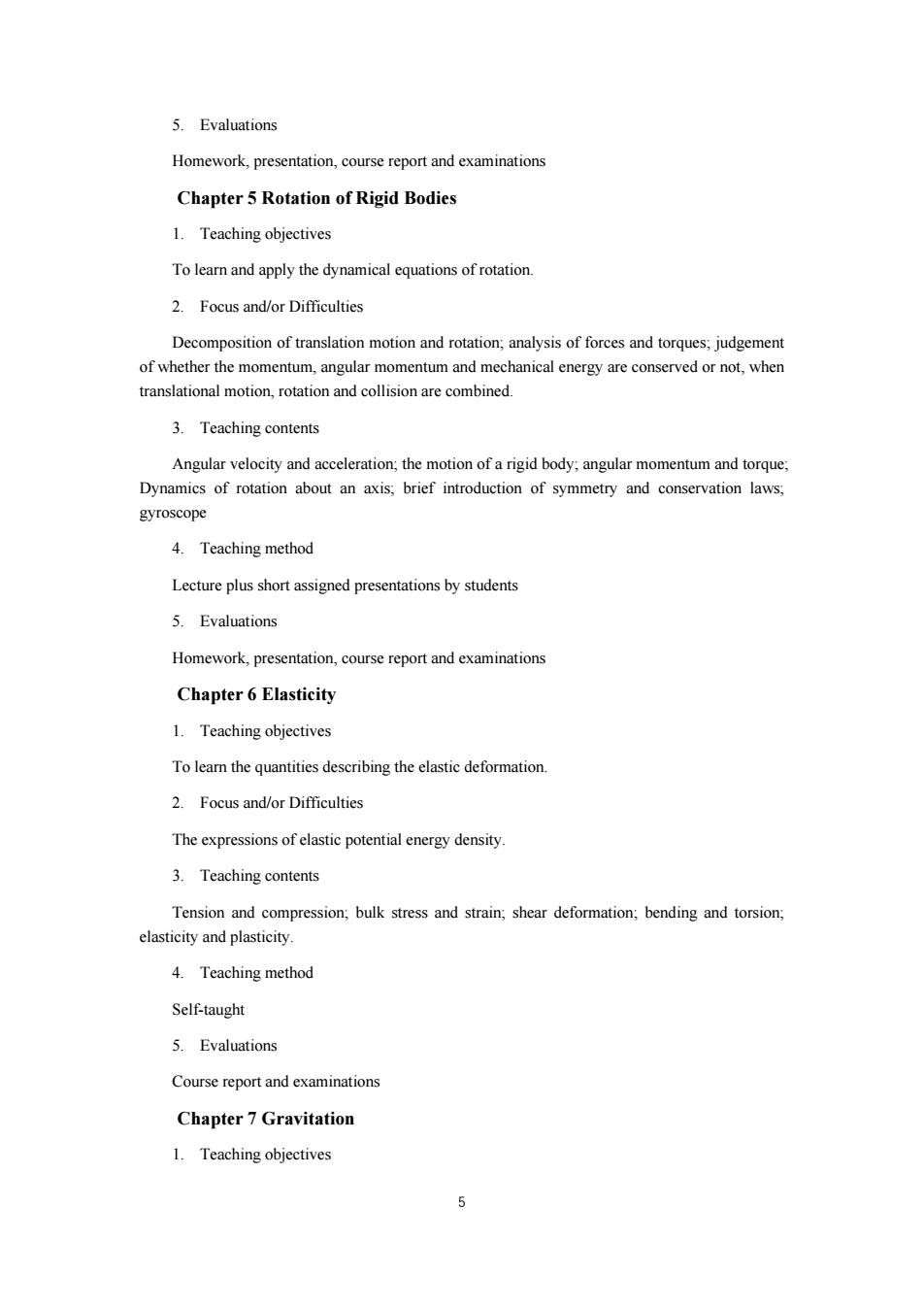
5.Evaluations Homework,presentation,course report and examinations Chapter 5 Rotation of Rigid Bodies 1.Teaching objectives Toleam and apply the dynamical of rotation 2.Focus and/or Difficulties Decomposition of translation motion and rotation,analysis of forces and torques,judgement of whether the momentum,angular momentum and mechanical energy are conserved or not,when translational motion rotation and collision are combined 3.Teaching contents Angular velocity and acceleration;the motion of a rigid body:angular momentum and torque, Dynamics of rotation about an axis,brief introduction of symmetry and conservation laws, gyroscope 4.Teaching method Lecture plus short assigned presentations by students 5.Evaluations Homework,presentation,course report and examinations Chapter6 Elasticity 1.Teaching objectives To learn the quantities describing the elastic deformation. 2.Focus and/or Difficulties The expressions of elastic potential energy density 3.Teaching contents Tension and compression;bulk stress and strain;shear deformation,bending and torsion. 4.Teaching method Self-taught 5.Evaluations Course report and examinations Chapter 7 Gravitation 1.Teaching objectives
5 5. Evaluations Homework, presentation, course report and examinations Chapter 5 Rotation of Rigid Bodies 1. Teaching objectives To learn and apply the dynamical equations of rotation. 2. Focus and/or Difficulties Decomposition of translation motion and rotation; analysis of forces and torques; judgement of whether the momentum, angular momentum and mechanical energy are conserved or not, when translational motion, rotation and collision are combined. 3. Teaching contents Angular velocity and acceleration; the motion of a rigid body; angular momentum and torque; Dynamics of rotation about an axis; brief introduction of symmetry and conservation laws; gyroscope 4. Teaching method Lecture plus short assigned presentations by students 5. Evaluations Homework, presentation, course report and examinations Chapter 6 Elasticity 1. Teaching objectives To learn the quantities describing the elastic deformation. 2. Focus and/or Difficulties The expressions of elastic potential energy density. 3. Teaching contents Tension and compression; bulk stress and strain; shear deformation; bending and torsion; elasticity and plasticity. 4. Teaching method Self-taught 5. Evaluations Course report and examinations Chapter 7 Gravitation 1. Teaching objectives
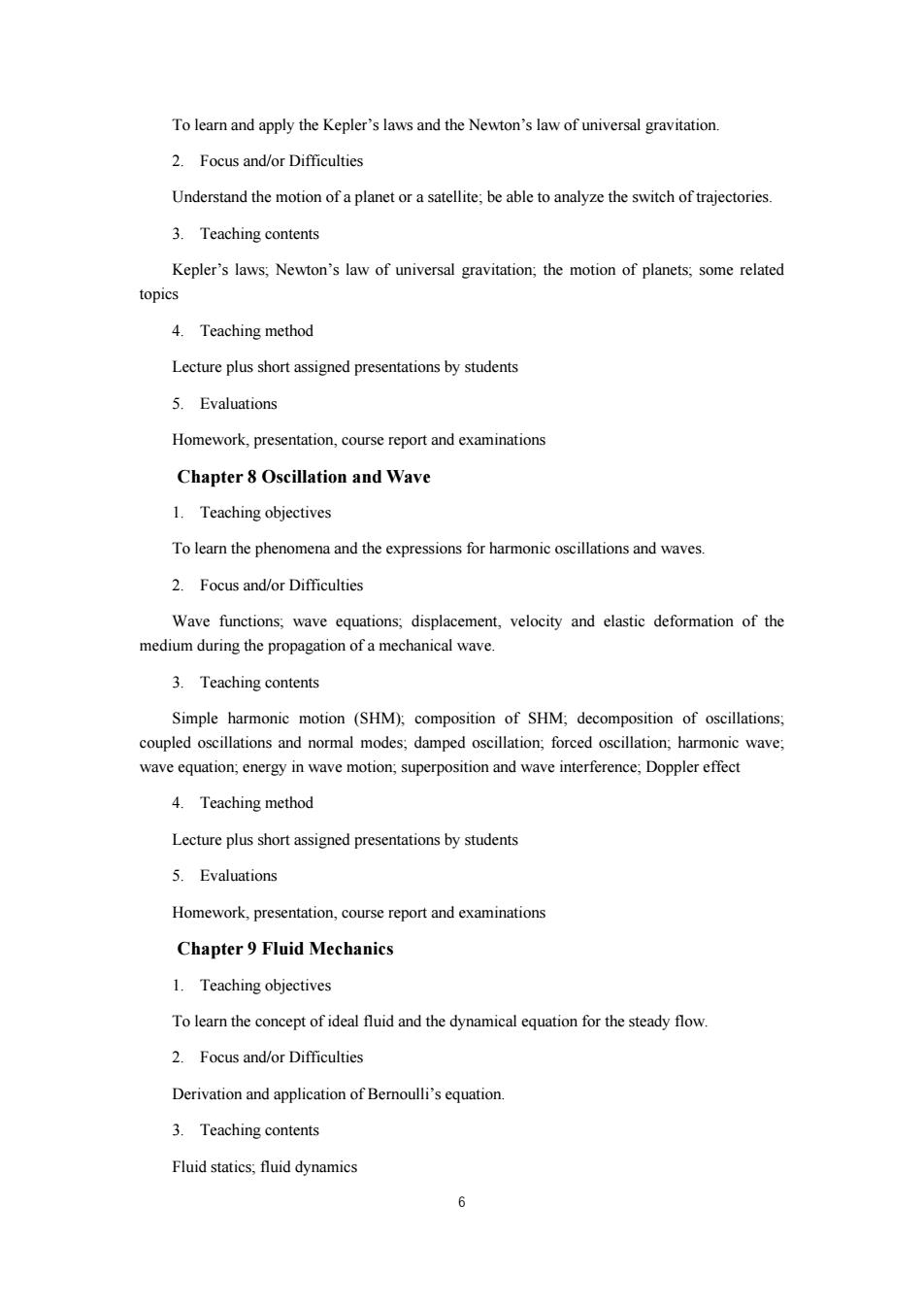
To learn and apply the Kepler's laws and the Newton's law of universal gravitation. 2.Focus and/or Difficulties Understand the motion of a planetora satellite be able toanalyze the switch of rajectories 3.Teachingcontents Kepler's laws:Newton's law of universal gravitation;the motion of planets:some related topics 4.Teaching method Lecture plus short assigned presentations by students 5.Evaluations Homework,presentation,ours report and examinations Chapter 8 Oscillation and Wave 1.Teaching objectives To learn the phenomena and the expressions for and waves 2.Focus and/or Difficulties Wave functions:wave equations:displacement.velocity and elastic deformation of the medium during the propagation of a mechanical wave. 3.Teaching contents Simple harmonie motion (SHM),composition of SHM:decomposition of oscillations. coupled oscillations and normal modes;damped oscillation;forced oscillation;harmonic wave; wave equation,energy in wave motion;superposition and wave interference,Doppler effect 4.Teaching method Lecture plus short assigned presentations by students 5.Evaluations Homework,presentation,course report and examinations Chapter9 Fluid Mechanics 1.Teaching objectives To learn the concept of ideal fluid and the dynamical equation for the steady flow. 2.Focus and/or Difficulties Derivation and application of Bemoull'sqtion 3.Teaching contents Fluid statics,fluid dynamics
6 To learn and apply the Kepler’s laws and the Newton’s law of universal gravitation. 2. Focus and/or Difficulties Understand the motion of a planet or a satellite; be able to analyze the switch of trajectories. 3. Teaching contents Kepler’s laws; Newton’s law of universal gravitation; the motion of planets; some related topics 4. Teaching method Lecture plus short assigned presentations by students 5. Evaluations Homework, presentation, course report and examinations Chapter 8 Oscillation and Wave 1. Teaching objectives To learn the phenomena and the expressions for harmonic oscillations and waves. 2. Focus and/or Difficulties Wave functions; wave equations; displacement, velocity and elastic deformation of the medium during the propagation of a mechanical wave. 3. Teaching contents Simple harmonic motion (SHM); composition of SHM; decomposition of oscillations; coupled oscillations and normal modes; damped oscillation; forced oscillation; harmonic wave; wave equation; energy in wave motion; superposition and wave interference; Doppler effect 4. Teaching method Lecture plus short assigned presentations by students 5. Evaluations Homework, presentation, course report and examinations Chapter 9 Fluid Mechanics 1. Teaching objectives To learn the concept of ideal fluid and the dynamical equation for the steady flow. 2. Focus and/or Difficulties Derivation and application of Bernoulli’s equation. 3. Teaching contents Fluid statics; fluid dynamics

4.Teaching method Self-taught 5.Evaluations Course report and examinations IV.Teaching Hours Table 2:Chapters and teaching hours Chapters Contents Hours Chapter0 Introduction 2 ChapterI Kinematics 4 Chapter2 Particle Dynamics 6 Chapter3 Work and Energy 4 Chapter4 Momentum,Impulse and 4 Collisions Chapter5 Rotation of Rigid Bodies 12 Chapter6 Elasticity 0 Chapter7 Gravitation 6 Oseillation and Wave 10 Chapter9 Fluid Mechanics 0 V. Teaching Schedule Table 3:Schedule Week Chapter Contents hours Assignments Note NA 1
7 4. Teaching method Self-taught 5. Evaluations Course report and examinations IV. Teaching Hours Table 2: Chapters and teaching hours Chapters Contents Hours Chapter 0 Introduction 2 Chapter 1 Kinematics 4 Chapter 2 Particle Dynamics 6 Chapter 3 Work and Energy 4 Chapter 4 Momentum, Impulse and Collisions 4 Chapter 5 Rotation of Rigid Bodies 12 Chapter 6 Elasticity 0 Chapter 7 Gravitation 6 Chapter 8 Oscillation and Wave 10 Chapter 9 Fluid Mechanics 0 V. Teaching Schedule Table 3: Schedule Week Chapter Contents hours Assignments Note 1 N/A N/A N/A N/A

2 NIA N/A NA NA NIA NIA NA NA NIA NIA NIA NIA Chapter Introduction, Homework:Selected 2+2 problems;One short and 1 Kinematics presentation at each class Kinematics,Particle Homework:Selected 6 and2 2+2 problems,One short Dynamics presentation at each class Homework Selected Chapter 2 Particle Dynamics 4 problems;One short presentation at each class Homework:Selected P Chapter 3 Work and Energy problems:One short presentation at each clas Homework:Selected 9 Momentum.Impulse Chapter4 problems;One short and Collisions presentation at each class Homework:Selected Rotation of Rigid Chapter 5 problems:One short Bodies presentation at each class Rotation of Rigic Homework:Selected 4 Bodies problems;One short presentation at each class Homework:Selected 12 Chapter 5 Rotation of Rigid Bodies problems;One short presentation at each class Midterm Midterm Exam: Homework Selected 13 Exam: Chapter 0 to 4: 2+2 problems:One short Chapter Gravitation Chapter 7 Gravitation 4 Homework:Selected
8 2 N/A N/A N/A N/A 3 N/A N/A N/A N/A 4 N/A N/A N/A N/A 5 Chapter 0 and 1 Introduction; Kinematics 2+2 Homework: Selected problems; One short presentation at each class 6 Chapter 1 and 2 Kinematics; Particle Dynamics 2+2 Homework: Selected problems; One short presentation at each class 7 Chapter 2 Particle Dynamics 4 Homework: Selected problems; One short presentation at each class 8 Chapter 3 Work and Energy 4 Homework: Selected problems; One short presentation at each class 9 Chapter 4 Momentum, Impulse and Collisions 4 Homework: Selected problems; One short presentation at each class 10 Chapter 5 Rotation of Rigid Bodies 4 Homework: Selected problems; One short presentation at each class 11 Chapter 5 Rotation of Rigid Bodies 4 Homework: Selected problems; One short presentation at each class 12 Chapter 5 Rotation of Rigid Bodies 4 Homework: Selected problems; One short presentation at each class 13 Midterm Exam; Chapter 7 Midterm Exam: Chapter 0 to 4; Gravitation 2+2 Homework: Selected problems; One short presentation at each class 14 Chapter 7 Gravitation 4 Homework: Selected
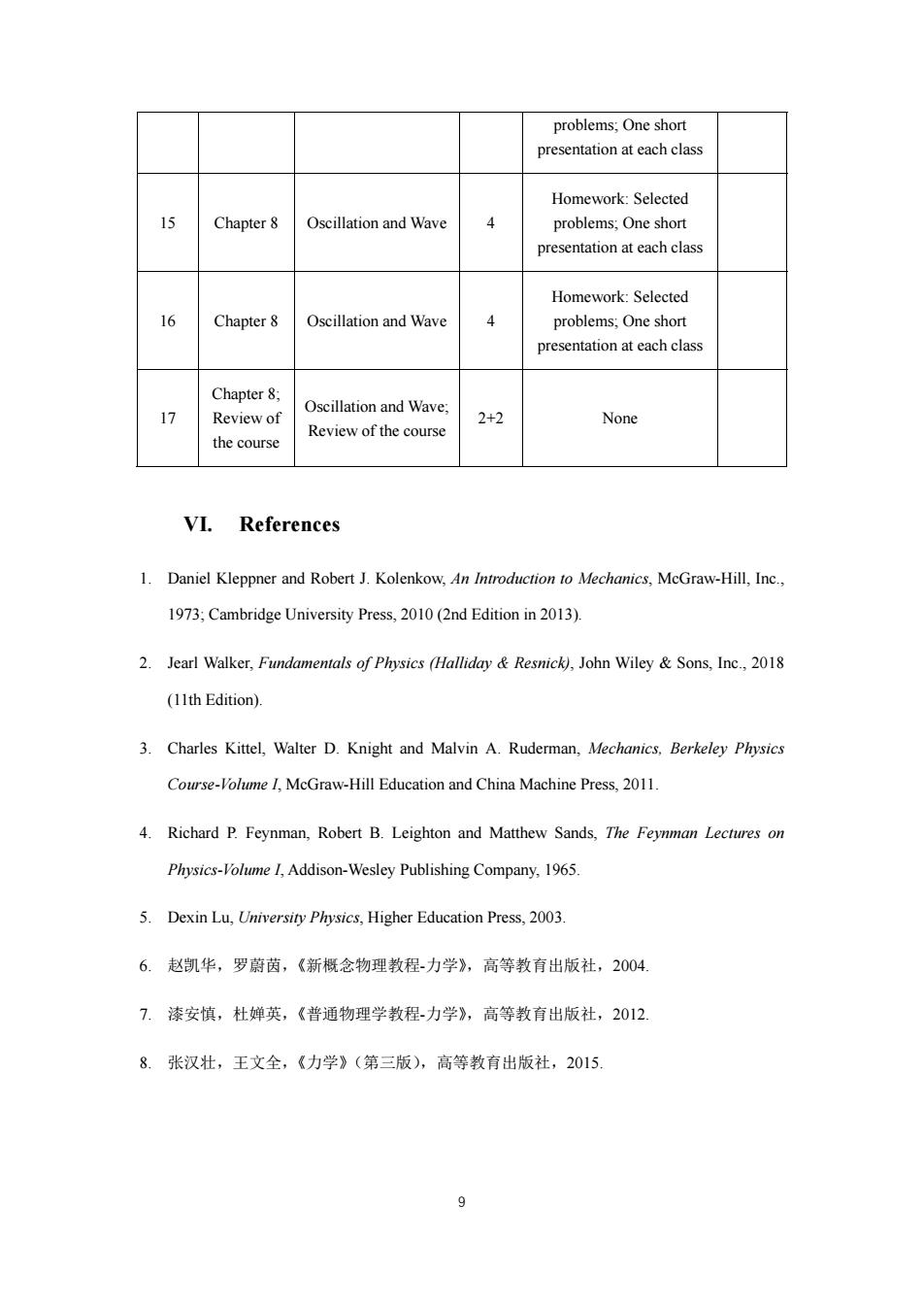
problems;One short presentation at Homework:Selected Chapter 8 Oseillation and Wave 4 problems.One short presentation at each clas Homework:Selected 6 Chapter 8 Oscillation and Wave 4 problems,One short presentation at each class 17 Review of Oscillation and Wave: 2+2 None Review of the course the course VI.References 1.Daniel Kleppner and Robert J.Kolenkow,An Introduction to Mechanics,McGraw-Hill,Inc. 1973,Cambridge University Press,2010(2nd Edition in013) 2.Jearl Walker,Fundamentals of Physics (Halliday Resnick),John Wiley&Sons,Inc.,2018 (11th Edition). 3.Charles Kittel,Walter D.Knight and Malvin A.Ruderman,Mechanics.Berkeley Physics Course-Volme,McGraw-Hill Education and China Machine Press,201 4.Richard P.Feynman,Robert B.Leighton and Matthew Sands,The Feynman Lectures on Physics-Volume I.Addison-Wesley Publishing Company.1965. 5.Dexin Lu,Universiry Physics,Higher Education Press,2003 6.赵凯华,罗蔚茵,《新概念物理教程力学》,高等教育出版社,2004 7.漆安慎,杜婵英,《普通物理学教程力学》,高等教有出版社,2012 8.张汉壮,王文全,《力学》(第三版),高等教有出版社,2015
9 problems; One short presentation at each class 15 Chapter 8 Oscillation and Wave 4 Homework: Selected problems; One short presentation at each class 16 Chapter 8 Oscillation and Wave 4 Homework: Selected problems; One short presentation at each class 17 Chapter 8; Review of the course Oscillation and Wave; Review of the course 2+2 None VI. References 1. Daniel Kleppner and Robert J. Kolenkow, An Introduction to Mechanics, McGraw-Hill, Inc., 1973; Cambridge University Press, 2010 (2nd Edition in 2013). 2. Jearl Walker, Fundamentals of Physics (Halliday & Resnick), John Wiley & Sons, Inc., 2018 (11th Edition). 3. Charles Kittel, Walter D. Knight and Malvin A. Ruderman, Mechanics, Berkeley Physics Course-Volume I, McGraw-Hill Education and China Machine Press, 2011. 4. Richard P. Feynman, Robert B. Leighton and Matthew Sands, The Feynman Lectures on Physics-Volume I, Addison-Wesley Publishing Company, 1965. 5. Dexin Lu, University Physics, Higher Education Press, 2003. 6. 赵凯华,罗蔚茵,《新概念物理教程-力学》,高等教育出版社,2004. 7. 漆安慎,杜婵英,《普通物理学教程-力学》,高等教育出版社,2012. 8. 张汉壮,王文全,《力学》(第三版),高等教育出版社,2015

VII.Teaching method 1.Lecture:PPT plus writing on the blackboard.Outlines,examples,schematic pictures and cartoon or movies are shown by PPT while derivations and solutions are performed on the blackboard.Examples are selected from the above listed reference books. 2.Presentation by students:Each student has one chance to give a short presentation on an assigned topic.Their performances are scored. 3.Course report:Each student should hand in a course report on a freely-chosen topic that is related to mechanics by the end the course. 4.Preview:All students are asked to preview the context before class 5.Self-education:Students need to study"Chapter6 Elasticity"and"Chapter Fluid Mechanics' by themselves. VIII.Assessment and Grading A.Correlations between assessment and course objectives Table 4:Correlations between assessment and course objectives Objectives Assessment points Way of assessment Objective1 Performance+Midterm Exam All teaching contents Final Exam Objective2 All teaching contents Performance+Midterm Exam +Final Exam Objective3 Performance+Midterm Exam All teaching contents +Final Exam Objective4 All teaching contents Performance+Midterm Exam Final Exam 10
10 VII. Teaching method 1. Lecture: PPT plus writing on the blackboard. Outlines, examples, schematic pictures and cartoon or movies are shown by PPT while derivations and solutions are performed on the blackboard. Examples are selected from the above listed reference books. 2. Presentation by students: Each student has one chance to give a short presentation on an assigned topic. Their performances are scored. 3. Course report: Each student should hand in a course report on a freely-chosen topic that is related to mechanics by the end the course. 4. Preview: All students are asked to preview the context before class. 5. Self-education: Students need to study “Chapter 6 Elasticity” and “Chapter 9 Fluid Mechanics” by themselves. VIII. Assessment and Grading A. Correlations between assessment and course objectives Table 4: Correlations between assessment and course objectives Objectives Assessment points Way of assessment Objective 1 All teaching contents Performance + Midterm Exam + Final Exam Objective 2 All teaching contents Performance + Midterm Exam + Final Exam Objective 3 All teaching contents Performance + Midterm Exam + Final Exam Objective 4 All teaching contents Performance + Midterm Exam + Final Exam